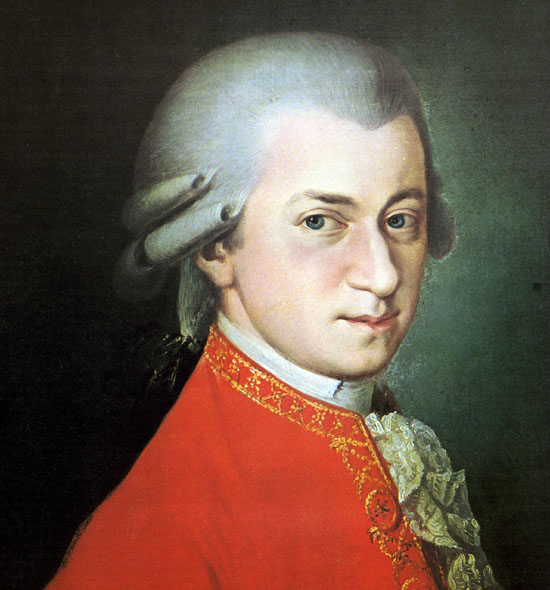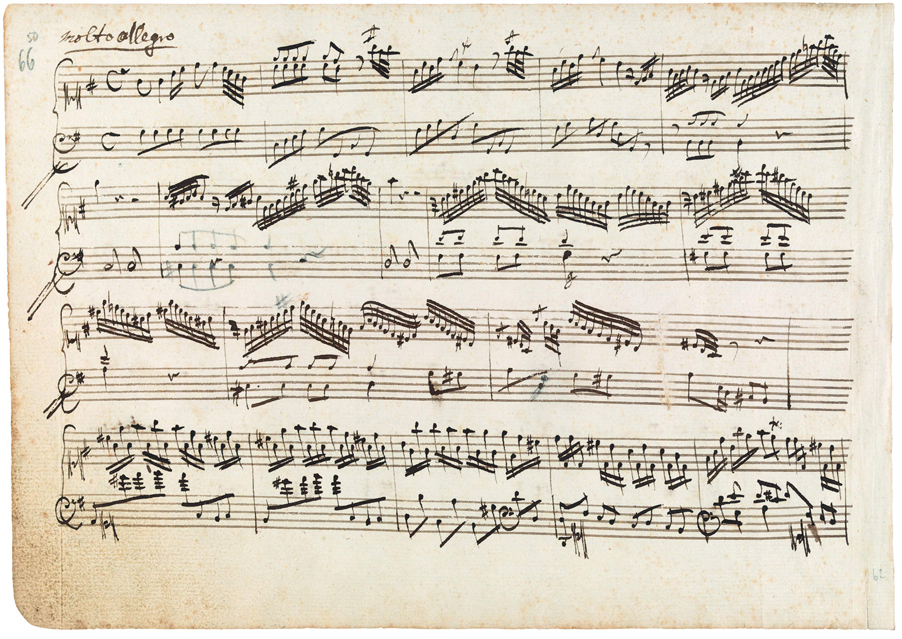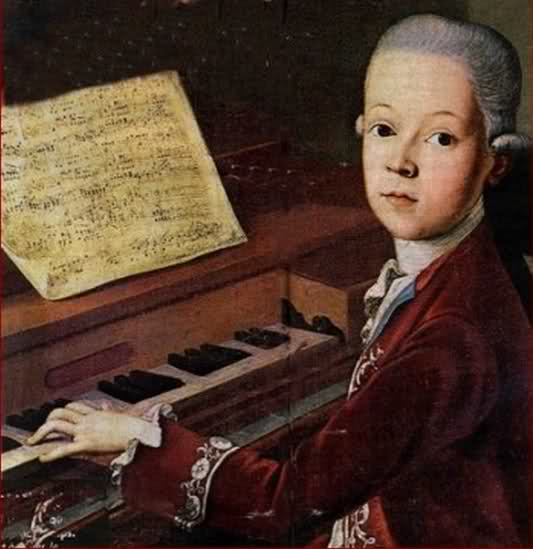
By Patrick Hunt –
In the great scheme of things theoretical, one might suppose that Classical music composition could be perceived as applied mathematics. Can ordered melody and harmonics and other elements in chord progressions somehow approach something like emotional equations, however subtle or sublime as in the case of Mozart or Bach or other composers of genius? If so, it ought to be less the scoring – in other words regardless of type of instrument – than the pure synthesis of how, when and where melody and harmony converge in what mode or key in a diatonic or other possible tonal system, for example, like a pentatonic scale. Whether or not this musical experience is universal or mostly culturally conditioned over time – would a listener in Africa a thousand years ago feel the same emotions in the musical progression as a European in the Baroque Era or a contemporary person of non-European ethnicity and culture today is of course moot, and therefore not so likely to be mathematically demonstrable.
With regard to Mozart, however, much has been suggested to connect his music with mathematics and even a possible predisposition to spatial-temporal reasoning and temporary mental enhancement when listening to his compositions – “ the so called “Mozart Effect” – although this idea bridles many Mozart connoisseurs who find such theories simplistic at best. Perhaps it is easier (and for some, even more profane) to maintain that Mozart ever consciously perceived mathematical relationships in his music. The literature and experimental history about the controversial “Mozart Effect” not always fully sensible, but more than a few mathematicians are fascinated by Mozart’s musical structures, also admitting one can never distill music down to bare numbers, however beautiful these may appear in both auditory and architectonic domains. To be expected, there have been many skeptics of the “Mozart Effect” who have pointed out problems inherent in experiments or analyses thereof and not all later investigators were able to reproduce the same effects of Rauscher et al (2). If the “Mozart Effect” is at all even remotely tenable (for example in his Sonata for Two Pianos K448 along with contrapuntal music of J. S. Bach like the Art of the Fugue) one of its possible positive enhancements of spatial-temporal reasoning appears to be connected with complex music of symmetry and long-term periodicity without overly repetitive elements. (3) More recent experiments have validated the “Mozart Effect” in performance enhancement of mathematics itself by the playing of Mozart in the background of university trigonometry exams, among others.(4) But is the “Mozart Effect” itself sufficient to make a connection between Mozart’s composition and mathematics? By itself, no, but there are other evidences that make a stronger case for Mozart’s own mathematical predisposition.

Because it is so accepted and no coincidence how much music and mathematics intertwine, it would be possibly fruitful and definitely fascinating to note whether and how mathematicians and physicists themselves enjoy the music of Mozart and Bach perhaps above all others; vice versa, it is well known that many musicians also train in mathematics. It must not be forgotten that Pythagoras devised a musical tuning based on mathematical harmonics in frequency ratios of whole number intervals and that Galileo’s father Vincenzo, a lutenist, wrote a treatise on string theory (pitch and string tension).(5) For example, although too numerous to detail, on the latter combination (music and math), virtuoso violist Raphael Hillyer (born Silverman), one of the founders of the Juilliard Quartet, had a degree in mathematics and his father was a mathematician. On the former combination (math and music), for example, Max Born, mathematical physicist, quantum mechanics pioneer and Nobel Laureate in 1954 for his work on statistical interpretation of the wave function in quantum mechanics, loved to play Bach on the piano daily; genius mathematician Leonhard Euler (1707-83) – who formulated a theory of musical consonance – was famous for his love of music and invited composers to his home to perform (6) and also had many notebooks on musical problems. (7)
Mathematicians have long noted that Mozart may have used Fibonacci Numbers (8) (named after Leonardo Pisano Bigollo and known as Fibonacci, (9) who also introduced and popularized Indo-Arabic numerals as far more utilitarian than Latin numerals) by using the Fibonacci Sequence in his Piano Sonata #1 in C major K279, not unlikely since his sister Nannerl noted he was always playing with numbers and even scribbled mathematical equations for probabilities in the margins of some compositions (e.g. Fantasia and Fugue in C Major, K394), some of which mathematicians suggest were Fibonaccci number calculations; he also may have used elements of the Golden Section (x, 1-x) in balancing his musical lines with the ratio of theme to development or musical exposition to recapitulation.(10) Other mathematicians have also verified some of the strong likelihood of Mozart’s dabbling in aspects of Euclidian mathematics like the Golden Section in his music. (11) Some have debated whether both Mozart and Bach loved musical gematria, (12) or symbolic number combinations in music. For example, in Mozart’s Don Giovanni, Leporello’s “catalogue aria” first recites the Don’s conquests as adding up to an unstated 1,062 (640 in Italy + 231 in Germany + 100 in France +91 in Turkey) then adds to this sum 1,003 conquests in Spain, making a total of 2065. The difference between the partial sums is 59 (1062-1003) and dividing the full sum (1062+1003) by the difference between the partial sums is 35, which may or may not be significant. In his earlier Marriage of Figaro, Figaro counts out in his footsteps the measure of his imagined quarters to be shared with Susanna: 5, 10, 20, 30, 36, 43, the sum of which is 144 or 12 squared, as others like de Sautoy have pointed out, again noting it may not have any additional meaning, although coincidence seems unlike Mozart. (13) I’m hoping to yet see what mathematics lie behind or within Mozart’s unique “Queen of the Night” aria from The Magic Flute, one of the most profoundly beautiful compositions ever written either regardless of or perhaps proportional to its curious lyrics.

Mario Livio, author and mathematical astrophysicist, also highlights the mathematical symmetry of Mozart’s music, especially his “symmetry under translation” as Livio notes and the sheer intellectuality of his music. Livio discusses Mozart’s Musical Dice Game Minuet of 16 measures with the choice of one of eleven possible variations in measure endings from random selection, each possibility selected by a roll of 2 dice, with literally trillions of possible mirror combinations. (14) Contemporary musician composers like Karl Ditters von Dittersdorf (1739-99) acknowledged of Mozart that “…he is undoubtedly one of the greatest of original geniuses and I have never know any other composer to possess such an amazing wealth of ideas.” (15) Mozart also loved writing musical themes from observing the bounces of a billiard ball off table corners and like phenomena and also was extremely adept at writing musical palindromes and an almost infinite variety of musical games as well as playful musical and literary punning. When I examine some of his scores, for example, his Symphony #40 in G minor, the developments and inversions of his musical themes are like contrapuntal and antiphonal number games between flute and violins, especially in bridging passages between measures 119 and following, again in fugal passages beginning in measures 150 ff & 160-220 in the first movement.(16) Mozart’s music often looks deceptively simple and is anything but, however rewarding is its complementary visual symmetry. As playfully childlike by nature he remained through life, he was not merely an automaton who received his music thoughtlessly. (17)
One of the ironies about Mozart is that his winter grave was unmarked and thus lost, unlike his music, as Alfred Einstein noted leaving nothing of his physical remains: “No earthly remains of Mozart survived except a few wretched portraits…as though the world-spirit wished to show that here is pure sound…” (18) The idea of pure sound in Mozart’s music is a poeticism that may ring true about his unique mathematical genius.
It has long been established that Mozart carried much of his music in his head before ever committing it to any manuscript. Livio concludes that one of the elements we love most about Mozart is the playful brilliance of his musical inventiveness that balances “predictability versus surprise” in a mathematical economy of variability that is exquisitely pleasing to the astute listener but may be also profoundly appreciated when the mind may not be consciously concentrating on the music itself. How much of this was intended by Mozart is impossible to know, but this is one of the ways genius works even intuitively, and what is intuition but the natural expression of the deepest level of the mind at work independent of effort? As Hutchings pointed out Mozart’s humility toward his own mortality despite his awareness of his musical uniqueness,(19) it may be this similar paradox floating between ephemerality and eternity as part of the timelessness that draws us to Mozart’s genius: his capacity for complexity. Ultimately, Mozart would probably agree on this: music is mathematics you can hear.
Notes:
(1) F. H. Rauscher, G. L. Shaw GL, K. N. Ky. “Music and spatial task performance.” Nature 365.6447 (1993) 611; F. H. Rauscher, G. L. Shaw, K. N. Ky. “Listening to Mozart enhances spatial-temporal reasoning: toward a neurophysiological basis.” Neuroscience Letters 185.1 (1995) 44-7; F. H. Rauscher, K. D. Robinson, J. J. Jens. “Improved maze learning through early music exposure in rats.” Neurological Research 20 (1998) 427-32; Lois Hetland. “Listening to Music Enhances Spatial-Temporal Reasoning: Evidence for the ‘Mozart Effect’.” Journal of Aesthetic Education 34.3/4 (2000) 105-49.
(2) C. F. Chabris. “Prelude or Requiem for the ‘Mozart Effect’?” Nature 400.6747 (1999) 826-7; D. M. Steele, S. Dalla Bella, I. Peretz et al. “Prelude or requiem for the `Mozart effect’?” Nature 400.6747 (1999) 827-8, among others.
(3) J. S. Jenkins. “The Mozart Effect.”Journal of the Royal Society of Medicine 94.4 (2001) 170-2.
(4) J. M. Taylor and B. J. Rowe. “The ‘Mozart Effect’ and the Mathematical Connection”. Journal of College Reading and Learning 42.2 (2012) 51-66.
(5) Patrick Hunt. “Galileo Galilei”. Great Lives in History: Inventors and Inventions. Salem Press, 2009.
(6) Ronald Callinger, historian of mathematics, with David Brown, “The Mozart of Mathematics: Leonhard Euler” The Washington Post transcript, April 10, 2007.
(7) Gerard Assayag, Hans Feichtinger, J. F. Rodrigues, eds. Mathematics and Music: A Diderot Mathematical Forum. Springer, 2002, 44. Chapter five in this book, “Musical Patterns” by W. Hodges and R. J. Wilson is a gold mine: canon, modified canon, retrograde motion, inversion and the twelve tone system.
(8) “Fibonacci Musical Composition”, Mathematical Thought MATH 2033, Dec. 12, 2011 (http://math2033.uark.edu/wiki/index.php/Fibonacci_Musical_Compositon). Supervised by Prof. E. Harriss.
(9) “Fibonacci’s Liber Abaci or Book of Calculation, published in Pisa in 1202.” Also see Richard E. Grimm. “Autobiography of Leonardo Pisano.” Fibonacci Quarterly 11.1 (1973) 99-104.
(10) John F. Putz. “The Golden Section and the Piano Sonatas of Mozart” in Mathematics Magazine 68.4 (1995) 275-82.
(11) M. May. “Did Mozart Use the Golden Section?” American Scientist 84 (1996) 118.
(12) George Knepler. Wolfgang Amedeus Mozart. Cambridge University Press, 1997, 137 (J. B. Robinson, tr). Here he questions Hans Josef Irmen, 1988.
(13) Marcus de Sautoy. “How Composers from Mozart to Bach Made Their Music Add Up.” The Guardian, April 4, 2013. Sautoy also quotes here: “Johann Andreas Schachtner, court trumpeter and friend of the Mozart family, wrote about the young Wolfgang: ‘When he was doing sums, the table, the chair, the walls and even the floor would be covered with chalked numbers. ‘ ”
(14) “The Mathematics of Mozart’s Music” Transcript. All Things Considered“ NPR. Jan. 26 2006. Also see Mario Livio. The Golden Ratio: The Story of Phi. Random House, 2003, 187-8.
(15) quoted in Alfred Hutchings. Mozart: The Man, The Musician. Schirmer Books, 1976, 84.
(16) F. Bonavia and Gordon Jacob, notes. Mozart, Symphony 40 in G Minor. Penguin Scores I – 2/6, Harmondsworth, Middlesex,England, 1949,13-15 (G. Jacob notes); also score 12-13, 16-20.
(17) Patrick Hunt. “Amadeus” in Masterplots. Salem Press, 2010, vol. 1, 4th ed., 160 & ff.
(18) Alfred Einstein. Mozart: His Character, His Work. Mendel and N. Broder, trs. Oxford University Press, 1945, 471.
(19) Hutchings, 99